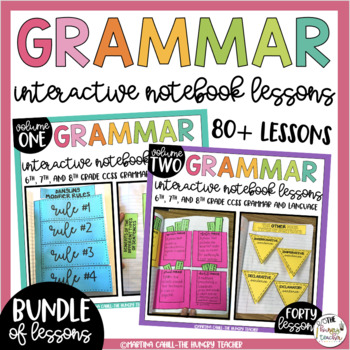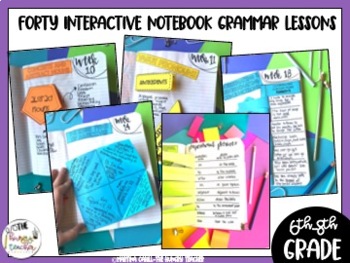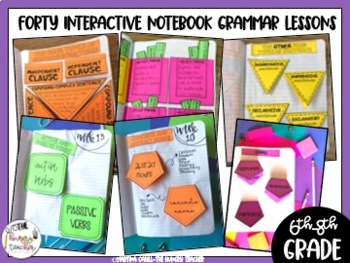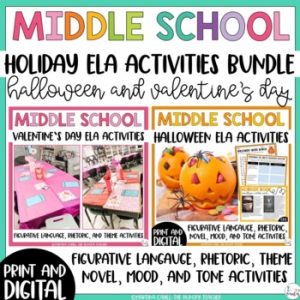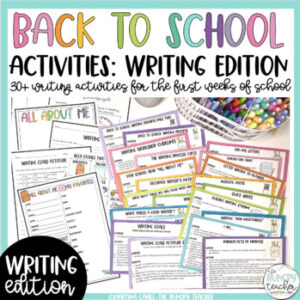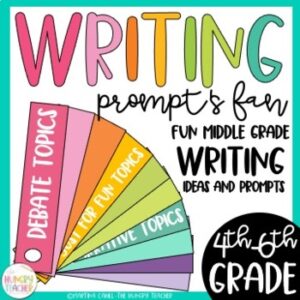Description
This middle school Interactive notebook grammar lesson bundle resource includes 80 different grammar lessons, activities, and examples for the 6th, 7th, and 8th grade Common Core Language standards.
Download the preview of either volume to see the table of contents along with examples of the lessons included.
THE FOLLOWING CONCEPTS AND LESSONS ARE IN VOLUME 1:
- The Parts of Speech
- The Four Sentence Types; Clauses
- Benefits of the Four Types of Sentences
- The Other Four Types of Sentences
- Subjects and Predicates
- Types of Phrases
- Action, Helping, and Linking Verbs
- Active and Passive Verbs
- Verbs
- Verb Tenses
- Verb Moods
- Verbals (Gerunds, Infinitives, Participles)
- Common and Proper Nouns
- Proper Noun Rules
- Plural Noun Rules
- Concrete and Abstract Nouns
- Intensive and Vague Pronouns
- Proper Pronoun Case
- Types of Pronouns
- Seven Types of Adjectives
- Superlative and Comparative Adjectives
- Dangling Modifier Rules
- Express Ideas Precisely and Avoid Redundancy
- Subordinating and Coordinating Conjunctions
- Direct and Indirect Objects: Objects of the Preposition
- Direct and Indirect Objects: Objects of the Preposition
- Prepositions and Prepositional Phrases
- Colon and Semi-Colons
- Quotation Mark Rules
- Punctuation Nonrestrictive Elements
- Punctuating and Capitalizing Titles
- Using Apostrophes in English
- Using Commas in English
- Using Numbers in English
- Common Prefixes and Their Meanings
- Using Word Clues to Determine Word Meanings
- Connotation and Denotation
- Common Homophones
- Author Tone and Style
- Commonly Confused Words
- Synonyms and Antonyms
- Who and Whom Differences
- Figurative Language
- The Three Types of Irony
THE FOLLOWING CONCEPTS AND LESSONS ARE IN VOLUME 2:
- Parts of Speech
- The Four Sentence Types
- Dependent and Independent Clauses
- The Other Four Sentence Types
- Subjects and Predicates
- Types of Phrases
- Action, Helping, and Linking Verbs
- Verb Tenses
- Verb Moods
- Active and Passive Verbs
- Verbals (gerunds, infinitives, and participles
- Common and Proper Nouns
- Plural Nouns
- Abstract and Concrete Nouns
- Vague Pronouns
- The Seven Types of Pronouns
- The Eight Types of Adjectives
- Comparative and Superlative Adjectives
- Dangling Modifiers
- Express Ideas Precisely and Eliminate wordiness and Redundancy
- Coordinating and Subordinating Conjunctions
- Prepositions and Prepositional Phrases
- Object of the Preposition
- Indirect and Direct Objects
- Quotation Mark Rules
- Using Dashes
- Commas
- Capitalization
- Colons and Semi-Colons
- Punctuating Non-Restrictive Elements
- Apostrophes
- Comma rules
- Using numbers in English
- Determining the Meanings of Unknown Words
- Using words and context clues to determine their meanings
- Homophones
- Connotation and denotation
- Who vs. whom
- Figurative Language: Definitions
- Figurative Language: Metaphors, similes, personification, allusion, hyperbole, alliteration, idiom.
- Figurative Language: The Three Types of Irony
